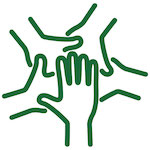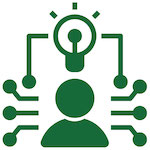Adaptive Design and Problem Solving
 Students who effectively employ adaptive design and problem solving are strong and creative thinkers.
Students who effectively employ adaptive design and problem solving are strong and creative thinkers.They exercise innovation, critical thinking, and risk taking in the design, implementation, and evaluation of an approach to achieve a desired goal.
What this could look like across a program, for a learner, and in a single course:
| When I am learning | When I am ready to work with others | When I am prepared for my career | |
|---|---|---|---|
| What competency development might look like across a program... |
I use a range of sources to gather information relevant to a problem and conduct a thorough analysis to understand an issue. I use discipline-specific language and knowledge to help define problems and clarify their context. |
I communicate ideas and solutions clearly and with an appropriate level of detail and I am sensitive to the diversity of others, which makes better solutions. I use my personal strengths, knowledges and talents to generate and support solutions, and complement those of others. |
I consider the broader, systemic implications of possible solutions. I develop viable, inclusive solutions that foster equity and provide opportunity for everyone to engage. |
| What this might look like for a student... | Oxana uses a range of information to identify why the business plan is not likely to be successful and describes why the projected profits are unlikely in the first year. | Oxana prefers to solve problems methodically and thoughtfully, but she participates actively when her group brainstorms potential solutions. She reaches a better solution than she thought of when she combines her initial thinking with Shaba’s observations about limitations. | Oxana works with a team to design a business plan with the most effective solutions given the available grants and the systemic barriers BIPOC entrepreneurs face. |
| What this might look like in a course... | In Dr. Liu’s Advanced Public Health course, students engage in an outbreak response simulation to develop adaptive design and problem-solving skills. Divided into interdisciplinary teams, students gather and analyze data on a fictional disease outbreak, define the problem using discipline-specific knowledge, and collaboratively develop response strategies. They implement these strategies in phases, adjusting based on new information, and reflect on their experiences through presentations and portfolio documentation. This simulation emphasizes real-time decision-making, interdisciplinary collaboration, and the creation of inclusive solutions that consider broader systemic implications, providing a practical and immersive learning experience. | ||
Undergraduate Student Competency Program Rubrics – utilize or adapt this rubric for programs and courses.
Other ideas for developing this competency in the classroom:
- Collaborative Design Challenges: Assign students to groups and give them a complex problem to solve. Provide guidelines for brainstorming sessions where each member contributes ideas. Require the group to develop a comprehensive solution that incorporates diverse perspectives. Facilitate regular check-ins to monitor progress and offer guidance.
- Problem-Based Learning (PBL): Provide students with detailed case studies relevant to their field. Ask them to analyze the case, identify the problems, and propose solutions. Discuss the case in class to highlight different approaches and the reasoning behind them.
- Case Study Analysis: Provide students with detailed case studies relevant to their field. Ask them to analyze the case, identify the problems, and propose solutions. Discuss the case in class to highlight different approaches and the reasoning behind them.
- Simulation Exercises: Use simulations to mimic real-world scenarios where students must apply their problem-solving skills. For example, in a business course, students could manage a virtual company and make decisions affecting its success. Reflect on the outcomes and discuss what could have been done differently.
- Service-Learning Projects: Partner with local organizations to create service-learning projects where students solve real-world problems that benefit the community. For example, engineering students could design accessible playground equipment, or business students could develop a marketing plan for a non-profit.
- Collaborative Workshops: Organize workshops where students and community members work together to solve problems. This can include brainstorming sessions, design thinking workshops, or hackathons. Facilitate reflection on how working with the community influenced their problem-solving process.
- Portfolio Development: Throughout the course, have students document each stage of their problem-solving activities in a portfolio. This should include research notes, drafts, final solutions, and reflections on their learning process.
Support
The Gwenna Moss Centre for Teaching & Learning
- Connect with us to get one-to-one strategies to help learners develop this competency in your classroom. Email gmctl@usask.ca for information.
Career Services
- FUSION modules: Problem Solving, Adaptability, Collaboration, Ditigal Literacy (AI), Creativity & Innovation
University Library
- Critical Thinking Tutorial - Resources that guide students in developing critical analysis skills, essential for solving complex problems.
- Math and Stats help guide - Provides support for building quantitative reasoning skills, helping students approach problem-solving more analytically.
- Learning Hub - helps instructors find academic skills resources, tutorials, and other learning support services for students. These resources can be integrated into courses as appropriate to support the development of USask graduate competencies
- Instructors can request workshops and custom materials from learning specialist and librarians tailored to course needs to support the USask graduate competencies.
Office of Vice-President Research:
- FYRE: The First Year Research Experience is an opportunity for instructors to integrate research projects into first-year courses, helping students develop critical research skills such as problem-solving, data analysis, and communication.





